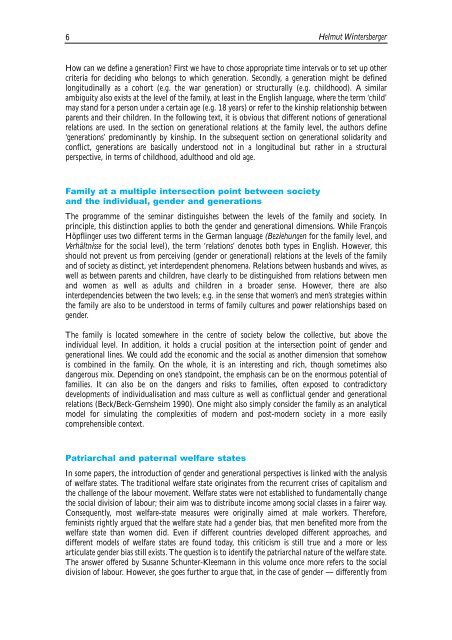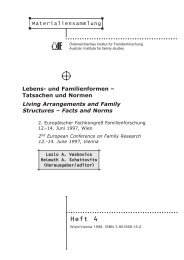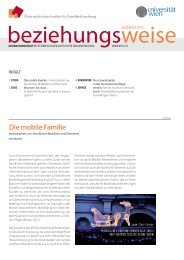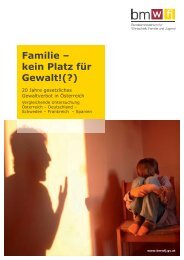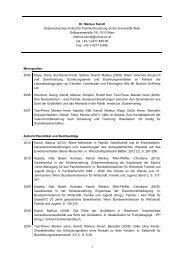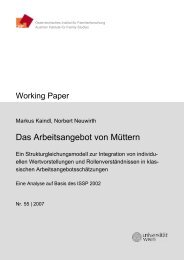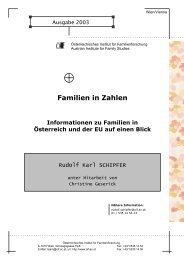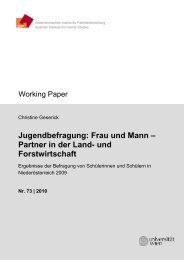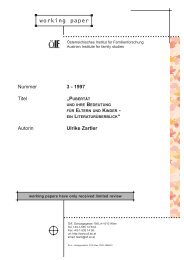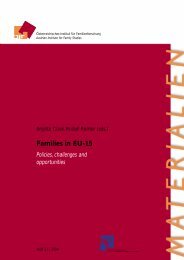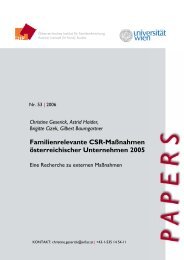Family issues between gender and generations
Family issues between gender and generations
Family issues between gender and generations
Create successful ePaper yourself
Turn your PDF publications into a flip-book with our unique Google optimized e-Paper software.
6 Helmut Wintersberger<br />
How can we define a generation? First we have to chose appropriate time intervals or to set up other<br />
criteria for deciding who belongs to which generation. Secondly, a generation might be defined<br />
longitudinally as a cohort (e.g. the war generation) or structurally (e.g. childhood). A similar<br />
ambiguity also exists at the level of the family, at least in the English language, where the term ‘child’<br />
may st<strong>and</strong> for a person under a certain age (e.g. 18 years) or refer to the kinship relationship <strong>between</strong><br />
parents <strong>and</strong> their children. In the following text, it is obvious that different notions of generational<br />
relations are used. In the section on generational relations at the family level, the authors define<br />
‘<strong>generations</strong>’ predominantly by kinship. In the subsequent section on generational solidarity <strong>and</strong><br />
conflict, <strong>generations</strong> are basically understood not in a longitudinal but rather in a structural<br />
perspective, in terms of childhood, adulthood <strong>and</strong> old age.<br />
<strong>Family</strong> at a multiple intersection point <strong>between</strong> society<br />
<strong>and</strong> the individual, <strong>gender</strong> <strong>and</strong> <strong>generations</strong><br />
The programme of the seminar distinguishes <strong>between</strong> the levels of the family <strong>and</strong> society. In<br />
principle, this distinction applies to both the <strong>gender</strong> <strong>and</strong> generational dimensions. While François<br />
Höpflinger uses two different terms in the German language (Beziehungen for the family level, <strong>and</strong><br />
Verhältnisse for the social level), the term ‘relations’ denotes both types in English. However, this<br />
should not prevent us from perceiving (<strong>gender</strong> or generational) relations at the levels of the family<br />
<strong>and</strong> of society as distinct, yet interdependent phenomena. Relations <strong>between</strong> husb<strong>and</strong>s <strong>and</strong> wives, as<br />
well as <strong>between</strong> parents <strong>and</strong> children, have clearly to be distinguished from relations <strong>between</strong> men<br />
<strong>and</strong> women as well as adults <strong>and</strong> children in a broader sense. However, there are also<br />
interdependencies <strong>between</strong> the two levels; e.g. in the sense that women’s <strong>and</strong> men’s strategies within<br />
the family are also to be understood in terms of family cultures <strong>and</strong> power relationships based on<br />
<strong>gender</strong>.<br />
The family is located somewhere in the centre of society below the collective, but above the<br />
individual level. In addition, it holds a crucial position at the intersection point of <strong>gender</strong> <strong>and</strong><br />
generational lines. We could add the economic <strong>and</strong> the social as another dimension that somehow<br />
is combined in the family. On the whole, it is an interesting <strong>and</strong> rich, though sometimes also<br />
dangerous mix. Depending on one’s st<strong>and</strong>point, the emphasis can be on the enormous potential of<br />
families. It can also be on the dangers <strong>and</strong> risks to families, often exposed to contradictory<br />
developments of individualisation <strong>and</strong> mass culture as well as conflictual <strong>gender</strong> <strong>and</strong> generational<br />
relations (Beck/Beck-Gernsheim 1990). One might also simply consider the family as an analytical<br />
model for simulating the complexities of modern <strong>and</strong> post-modern society in a more easily<br />
comprehensible context.<br />
Patriarchal <strong>and</strong> paternal welfare states<br />
In some papers, the introduction of <strong>gender</strong> <strong>and</strong> generational perspectives is linked with the analysis<br />
of welfare states. The traditional welfare state originates from the recurrent crises of capitalism <strong>and</strong><br />
the challenge of the labour movement. Welfare states were not established to fundamentally change<br />
the social division of labour; their aim was to distribute income among social classes in a fairer way.<br />
Consequently, most welfare-state measures were originally aimed at male workers. Therefore,<br />
feminists rightly argued that the welfare state had a <strong>gender</strong> bias, that men benefited more from the<br />
welfare state than women did. Even if different countries developed different approaches, <strong>and</strong><br />
different models of welfare states are found today, this criticism is still true <strong>and</strong> a more or less<br />
articulate <strong>gender</strong> bias still exists. The question is to identify the patriarchal nature of the welfare state.<br />
The answer offered by Susanne Schunter-Kleemann in this volume once more refers to the social<br />
division of labour. However, she goes further to argue that, in the case of <strong>gender</strong> — differently from


